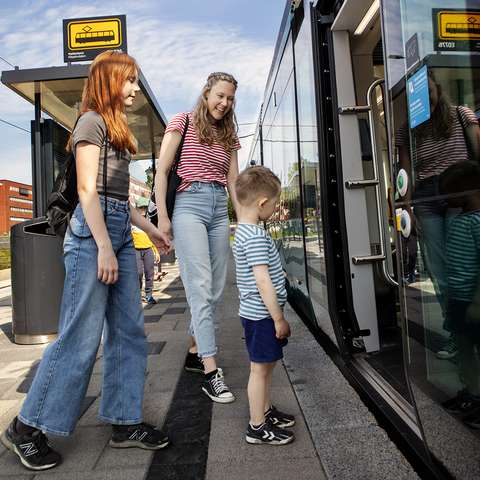Tell us what kind of Espoo you want to live in
Everyone in Espoo, regardless of age, can have a say in what kind of values are fostered in their hometown. So, respond to the My Espoo survey and be part of writing the Espoo story!
Espoo’s strategy is called the Espoo Story. It is updated at the beginning of each council term, with the next update coming in autumn 2025.
Espoo residents can participate in the preparation of the Espoo Story by taking the My Espoo survey at espoo.fi/en/myespoo. Completing the survey takes about five minutes.
The wishes of the respondents will be taken into account by the council as it sets the objectives for its term and the city’s performance targets.
“The My Espoo survey is a real opportunity to have a say in what kinds of things and values are implemented in Espoo. It’s definitely worth taking,” encourages Mayor Jukka Mäkelä.
This is the fourth time the survey is being conducted. In recent years, responses have highlighted the significance of nature, the importance of safety and the wellbeing of children and young people.
Espoo residents value nature
According to the My Espoo survey, the people of Espoo are proud of the unique nature of their hometown, year after year. Promoting biodiversity is recorded in Espoo’s goals.
There are around 50 nature reserves in the city area, such as the Tremanskärr mire reserve, the Kurkijärvi forest nature reserve, and the Lippajärvi nature reserve, which was established back in the 1960s. The archipelago’s nature reserves include Pentala and Stora Herrö.
“Every year, new nature reserves are set up. Most recently, a nature reserve was established at Friisinkallio in Central Park, and next year’s programme includes a nature reserve for Mätäjärvi in Hanikka,” says Environmental Planner Katrin Aia from Espoo’s Environmental Protection Unit.
In nature reserves, there are ready-made paths and built routes for travel. Berries and mushrooms may also be picked outside the path, but collecting or disturbing other plants is prohibited.
(The text continues after the photo.)
Children get to enjoy hobbies at their own school
Espoo residents also want the city to invest in the wellbeing of children and young people. Children are offered meaningful leisure activities close to home, which helps them live a balanced life.
For two years now, the pupils of Matinlahden koulu have had the opportunity to participate in a variety of after-school hobby activities at their own school. Activities include exercise, theatre improvisation, scout activities, chess and music.
“Our pupils are able to get to their hobbies on their own. Parents can skip chauffeur duties, and evenings are left free for family time,” says Anssi Iivonen, Principal of Matinlahti School.
Espoo’s cultural and youth services have selected Matinlahti’s hobby organisers based on a tender competition. The majority of the hobbies are free of charge, so a family’s financial situation does not affect participation. After all, one of the goals is to prevent inequality.
“For many, this is the first time they have been able to have any hobbies at all. Our intention is to supplement the activities offered by clubs and organisations,” Iivonen says.
He explains that many children are enthusiastic about the activities and that the school has sent messages to their homes about the importance of hobbies. Parents who are just learning Finnish have received help signing their children up for hobbies, which has been a much-needed help for many families.
(The text continues after the photo.)
Transportation in Espoo is already sustainable
In its strategy, Espoo is committed to carbon neutrality by 2030, which is an important value for Espoo residents. However, people want to be able to get from one place to another safely and without undue effort.
Espoo has traditionally been a city for private car drivers, but now there has been a significant change: the share of walking, cycling and public transport in all modes of transport has risen to as much as 59 per cent. The share of private car use has decreased by as much as six percentage points in five years.
“The result is astonishingly good, as a change of just one percentage point already requires a lot of background work. In Espoo, the proportion of walking has also increased significantly,” says Pauliina Kuronen, City Transport Manager at the Public Works Department.
The metro has reduced the need for private cars – also because residential buildings and business centres built along the tracks are within walking distance for an increasing number of people. Cycling has been promoted by building high-quality bicycle parking next to metro stations, as has been done in Espoonlahti and Tapiola.
The light rail line 15 is aiming for 50,000 daily trips, which will likely be reached soon when the interval is reduced from eight to six minutes.
“The light rail line 15 is the first step towards an Espoo that is based on network-like rail traffic, as the line operates between Itäkeskus and Keilaniemi. Until now, you could only travel by rail to the centre of Helsinki and back,” says Kuronen.
The Espoo Rail Line under construction from Leppävaara to Kauklahti via Espoon keskus will further increase the opportunities to use public transport in Espoo.
Text: Susanna Cygnel
This article has originally been published in the Espoo Magazine 2/2024. Read other articles in the Espoo Magazine.
